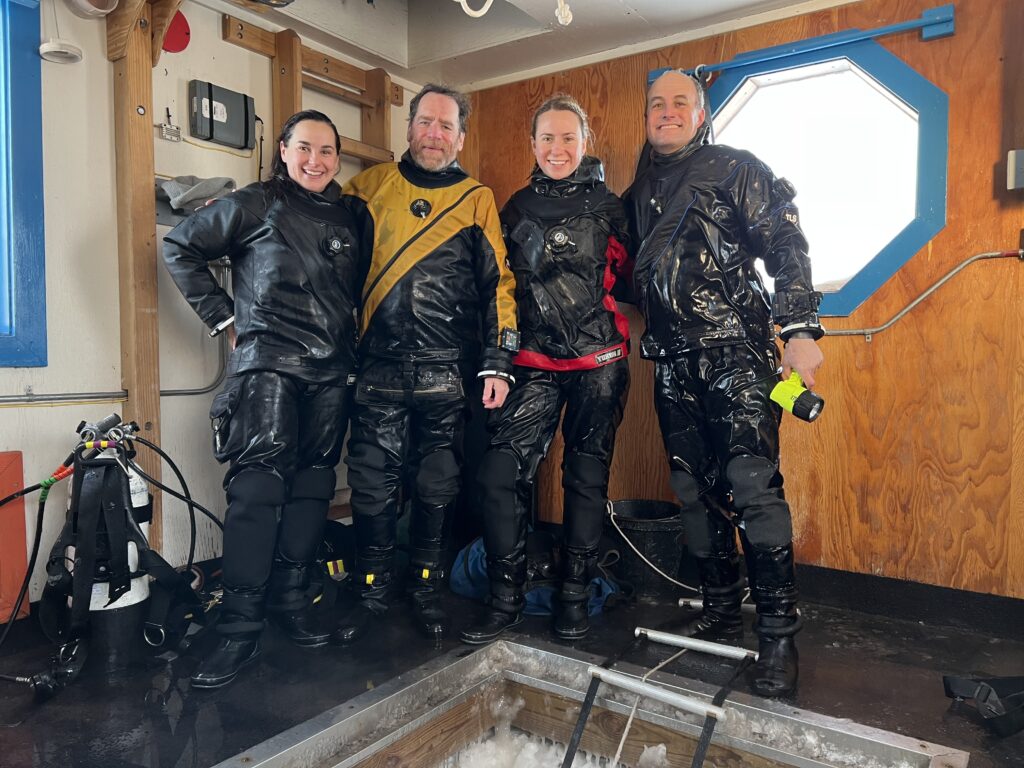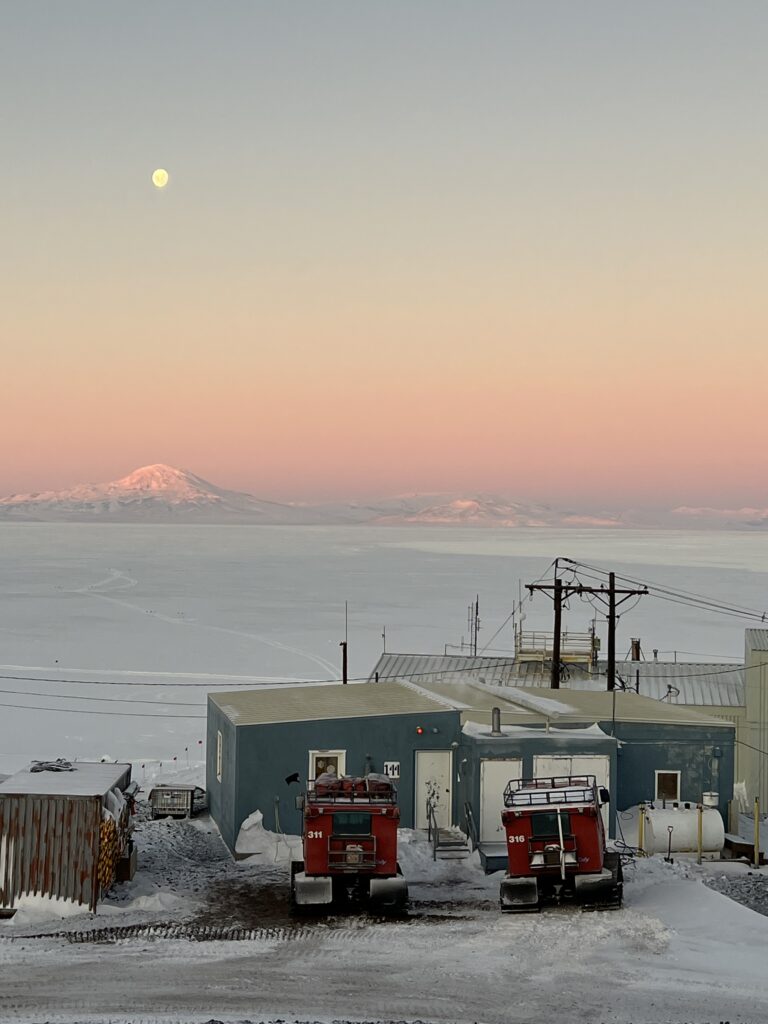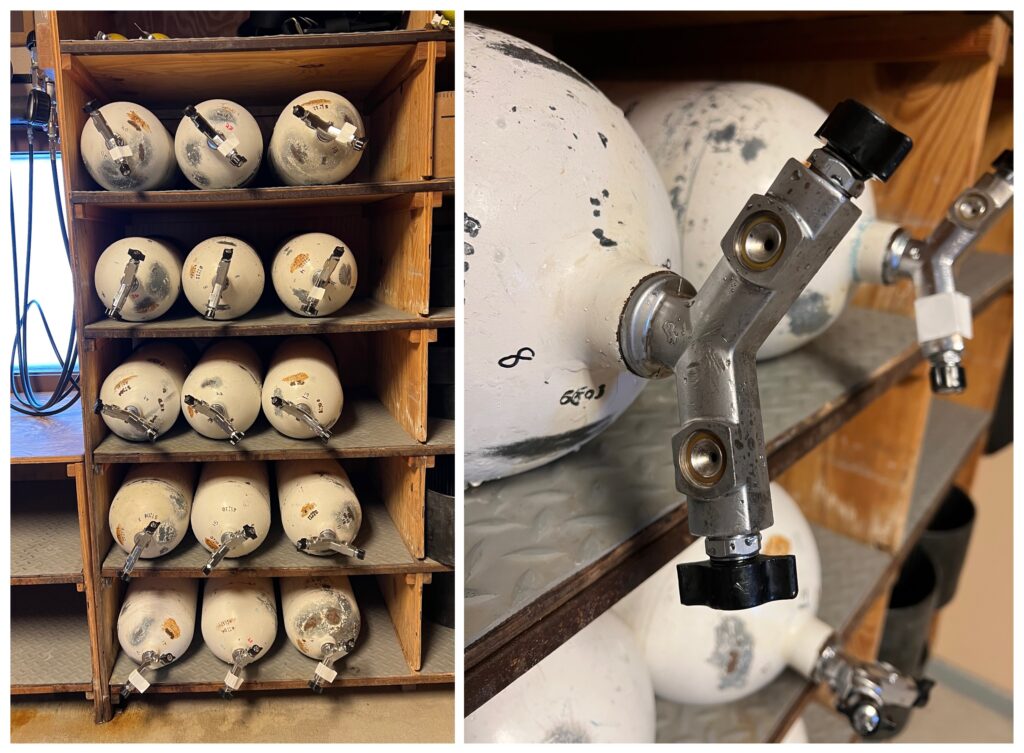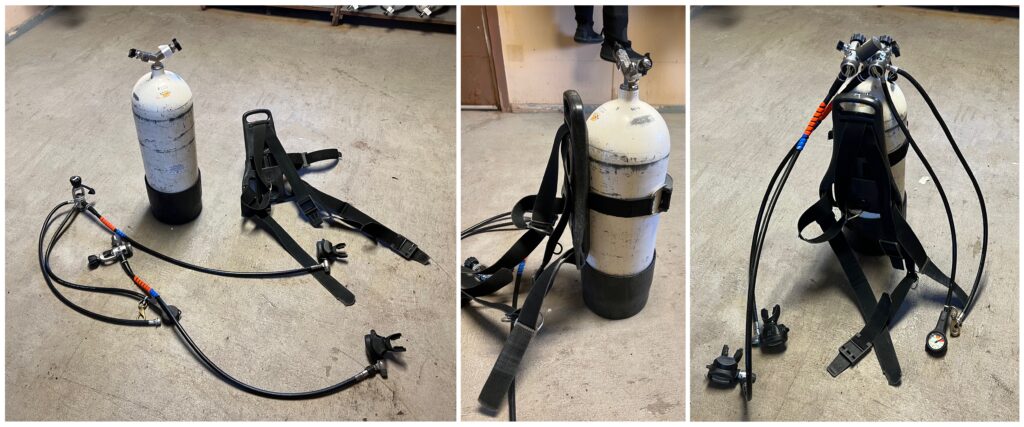We did our first dive 16 days ago (on September 7th), and since then, we have done ~20 dives! Here is a group photo we took immediately after our first full dive.

The first dive we did took a long time to get ready for. The only kit we brought with us was our dry suits and thermal under-suits. Everything else was provided by the United States Antarctic Program (USAP). Antarctic waters are among the coldest a research diver can expect to experience (-1.89°C or 28.6°F in McMurdo Sound). In these temperatures, not all diving equipment can be expected to operate properly, and malfunctions can be frequent if the wrong kit is used.
USAP’s diving gear is tried-and-tested, and therefore less likely to fail compared to personal gear, which can be of various models, ages, and qualities. Diving under the ice in Antarctica is not the place where you want your gear to break! So, for this reason, our first dive was slow as we had to check, and re-check our kit, some of which we had never used before. However, two weeks later, we finally got into a nice rhythm. So, for today’s blog, I thought I would walk you through our daily routine of getting kitted up and ready to dive!
At 8:30 am, I walk from the lab down to the dive locker (the little blue building in the photo below). The view on this walk is just awful guys…

Next its time to grab a tank:

The tanks we use are 2400 psi (pounds per square inch) steel cylinders (95 cu ft or 2690 L volume). Steel cylinders are preferred to aluminum cylinders for durability in cold temperatures. Here at McMurdo, divers are required to use two fully independent first and second-stage regulators (a regulator is a device that delivers air to the diver’s mouth underwater). This is because if one freezes and starts to free-flow (i.e., purging air uncontrollably), you can easily turn off the gas to that one, pick up your second regulator and keep breathing…yay! So, for that reason, the cylinders here have a “Y” valve, as shown above.
Next, it’s time to grab the regulators:

The only regulators which are currently approved for use here at McMurdo are the Sherwood Maximus SRB 7600 first and second-stage regulators (shown above). As you can see, one of them has three hoses attached, and these are for 1) your backup regulator, 2) the air pressure gauge, and 3) the dry suit inflator hose. The other regulator only has one hose: for the main regulator. As this regulator only has one hose, valve, O-ring, etc., it is less likely to freeze and/or fail (*knocking on wood frantically*).
Next, it’s time to attach the backplate and the regulators to the cylinder:

The backplate allows us to strap the tanks to our back. This is a good time to turn on the air and check that the tanks are full by looking at the mechanical pressure gauge.
After the tanks are set up, it’s time to pack up our gear bags. All the gear is washed and hung up at the end of every day. Luckily, Antarctica is of the driest places on earth, so our gear is always dry-as-a-bone in the morning!

After loading our tanks and bags into the Pistin Bully (the tracked vehicle we use for getting out onto the sea ice), it’s time to get suited up! The first layer we wear is long underwear thermals, as modeled by Andrew below:

Next, we don our thick insulating layer.

We use The Weezle Extreme Plus undersuit – and I have to say, this thing is amazing. It’s like wearing a sleeping bag – it is SO cozy. In fact, a few months ago, I actually took this camping, and it was perfect!
After this, we wriggle into our dry suits:

We are using the DUI Yukon II suits and they are wonderful. They were made to measure and are by far the best dry suit I have ever used.
Now that we are suited up, we load into the Pistin Bully (red vehicle shown below) are begin the very long drive to our dive hut. It takes approximately 3 minutes to get there 😂

We then unload our kit into the shed. Check out this video:
When we are situated within the warm cozy dive hut, we start to get kitted up!
The first thing we do when we sit next to the dive hole is to put on our ankle weights (2lbs). The ankle weights are just to help us maintain a horizontal position (or trim) when underwater.

Next, we put on our fins. This is a very important step because if we fall into the hole, we want to be able to kick and stay afloat! Lila models this below:

Sometimes, one of us forgets to don the fins first, at which point the team will ask them “have you ever been to FINland?” or “are you sure you’re FINished?”…. sarcasm and puns-galore in the dive hut, daily 😂
Next, we wrestle into the weight belts:

We are using DUI weight harnesses with ditch-able weight pockets. Each of us is wearing 40 lbs (or 18 kg) of lead weight, and boy – are they heavy! We need this much weight to help us sink, as our Weezle undersuits are so puffy, and therefore extra-buoyant. Now is the time in the process to be extra careful: you don’t want to fall into the hole wearing all that weight, but with no tank.
So naturally, the next item we strap ourselves into is the tank-backplate/reg set-up.

But first… the most important step of the day: MAKE SURE YOUR AIR IS ON! This step is so important (for obvious reasons) that when we do it, we even call out “I am turning my air on” to let everyone else know what we are doing – and to remind them to do it too!
Once the tank is attached around our shoulders and waist, we clip the dry suit inflator hose to our suit using the chest valve. In the photos below, the silver clip in the left photo attaches to the silver valve of the dry suit in the right photo.

This inflator hose lets us add air to our dry suit, which is how we control our buoyancy underwater. We do not use SCUBA Buoyancy Compensation Devices (BCDs) when diving under fast ice here at McMurdo. So, your dry suit is the only way in which we achieve neutral buoyancy underwater. This was a first for me in my diving career – and initially, it took some getting used to – but now it is second nature!
Then we clip the mechanical pressure gauge and backup regulator to our backplate webbing to keep them from dangling/dragging on the seafloor.
The next items we don are our hoods…plural!

Your head is an area of your body where you can lose the most body heat. Therefore, we wear lots of layers to try and stay warm.
The first hood we wear is made from thin neoprene (3-5mm thickness) and is referred to as a gorilla hood (top left hood in photos above). This hood covers all our head, except our eyes and mouth. Honestly, it looks like we are about to rob a bank when we put these on. They look a bit silly, but they do keep your face warm, which is more important!
The second hood is made of thin latex and is attached to our dry suits. This helps keep the icy cold water from getting near our neck seal, and around our head.
The outer hood is a thicker neoprene hood (7 or 11mm thickness) and is purely for thermal protection.
When all hoods are donned, we put on our masks.

We then have to carefully go around the silicon edge of mask and slide it underneath all the hoods. If we don’t manage to get a good seal, we would have a mask flood underwater, which would be annoying, but more importantly, horribly cold. Brrrrrr!
Next, it’s time for the dive computer. A dive computer provides all the real-time information divers need to be able to dive well, including depth, time, safety stop, and no decompression limit (NDL) data. All USAP divers must use the dive computers that are issued by the McMurdo dive lockers. Currently, they are the Shearwater Perdix AI model.

The computer communicates with an air pressure transmitter that is attached to our regulators, and therefore our computer knows exactly how much air we have left at all times.
The last step in getting suited up is our gloves. Hands are the main factor that determines the length of a dive in Antarctica – they get SO COLD! Once dexterity is lost in the diver’s hands, the dive needs to be ended quickly. For me, I can manage about 30 minutes under the ice. After that, my fingers start to get cripplingly sore, and I can’t really move them anymore. As I am usually carrying a camera, this makes it very difficult to take any more photos as I can’t even press the shutter button! More importantly, though, a diver needs to maintain dexterity at the end of a dive to be able to use their suit inflator or change to their backup regulator in an emergency.
We install dry gloves on our suits using the Kubi ring system.

With these, we can attach basically any rubberized glove to a ring. I bought the orange gloves shown above in a fishing supply store! The other ring attaches to the silicon wrist seal on our dry suits. Then these two rings push together and seal by means of a red O-ring. A simple but effective design! So long as no fluff or hairs are caught in the O-ring, we are able to keep our hands dry throughout the dive! Trust me, if there is a leak – you will know about it very quickly as you go underwater!
We insert small diameter plastic tubes under the silicon wrist seal on our dry suit to allow us to fill our gloves with air from the body compartment of our suits. This lets us equalize our hands at depth which prevents skin pinching caused by high pressure underwater, but more importantly, helps to keep our hands warm. Well… they are never warm. It helps us keep our fingers not frozen, which would be a better description!

Under the rubber gloves, we were fleece gloves. I also use hand warmers, as I get extra cold.

Regulators go into mouths, and it’s time to jump in! Check out this video of us getting into the ice hole:
The key is to twist your body enough so that the tank doesn’t catch on the wooden floor of the hut as you go down… because, ouchy.
Finally, here is the coolest video ever made. Andrew used his 360 degree-GoPro camera to film us getting kitted up and jumping into the dive hole!

